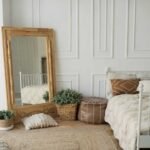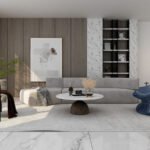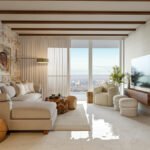Contemporary Style Contemporary interior design is a style that’s gaining popularity fast. It’s known for its clean lines, simple looks, and focus on function. This style can make any home, from a loft to a traditional house, look modern and striking.
The contemporary design movement started in the 1970s. It grew from the mid-century modern style and keeps getting updated. It’s all about comfort, elegance, and keeping things simple. By knowing what contemporary design is all about, you can make your home look amazing and welcoming.
Key Takeaways
- Contemporary design is characterized by clean lines, minimalist aesthetics, and a focus on function.
- The style emerged in the 1970s and continues to evolve, incorporating current trends and borrowing from various popular aesthetics.
- Contemporary design emphasizes comfort, sophistication, and a lack of clutter, showcasing space rather than objects.
- Incorporating contemporary elements can transform the ambiance of a space, creating a visually striking and modern environment.
- Understanding the key characteristics of contemporary design and learning how to integrate its essential elements is crucial to achieving the desired aesthetic.
Understanding Contemporary Design: A Modern Approach to Home Styling
Contemporary design has changed a lot since the 1970s. It mixes styles like modernism, postmodernism, and Art Deco. This style is known for clean lines, simple decor, and staying up-to-date.
Unlike modern design, which was popular from the 1900s to the 1950s, contemporary style keeps changing. It always shows what’s current.
Origins of Contemporary Design
In the 1970s, contemporary design started to become popular. It took bits from many styles, like modernism and postmodernism. This mix created a fresh look that keeps getting updated.
Key Characteristics of Contemporary Style
- Subtle sophistication
- Intentional simplicity
- Emphasis on space over objects
- Neutral palettes and stark minimalism
- Sleek, ornamental designs with curves and contrasting colors
Modern vs. Contemporary: Understanding the Difference
Modern and contemporary designs both like clean lines and simplicity. But they differ in their design choices and materials. Modern design, from the early to mid-1900s, focuses on warmth and natural materials like wood.
Contemporary style, however, is more varied and follows the latest trends. It often uses shiny finishes and bold colors.
“Contemporary design is always evolving and reflects the current decor trends of each decade.”
The Essential Elements of Contemporary Style
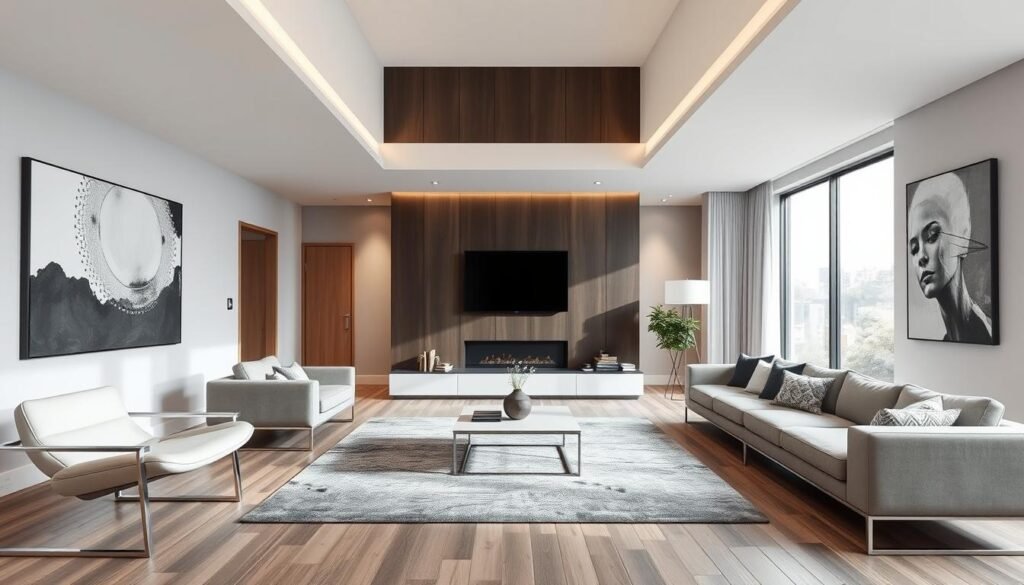
Contemporary style focuses on design elements that bring a clean, minimalist look. In these spaces, empty areas are just as important as the ones filled with things. Features like exposed ducts or pipes add an industrial touch.
At the core of contemporary style are open floor plans, clean lines, and sleek furniture. Interiors often use muted neutrals, black, and white, creating a lively feel. Bold colors are used as highlights to brighten up the space, and texture helps avoid a dull look.
Contemporary interiors often feature angular shapes and strong lines. They mix industrial and natural elements, like metal and polished wood. These designs prefer open spaces with lots of natural light from big windows.
Contemporary interior design is all about clean lines, sharp angles, and soft curves. Neutral colors like blue, gray, brown, and green are favored. But, vibrant colors add warmth to the space.
For furniture, warm wood tones, glossy finishes, and smooth textures are best. Add sleek touches like shiny metals, natural stone, chic tiles, and designer fabrics.
Color Palettes and Materials in Contemporary Design
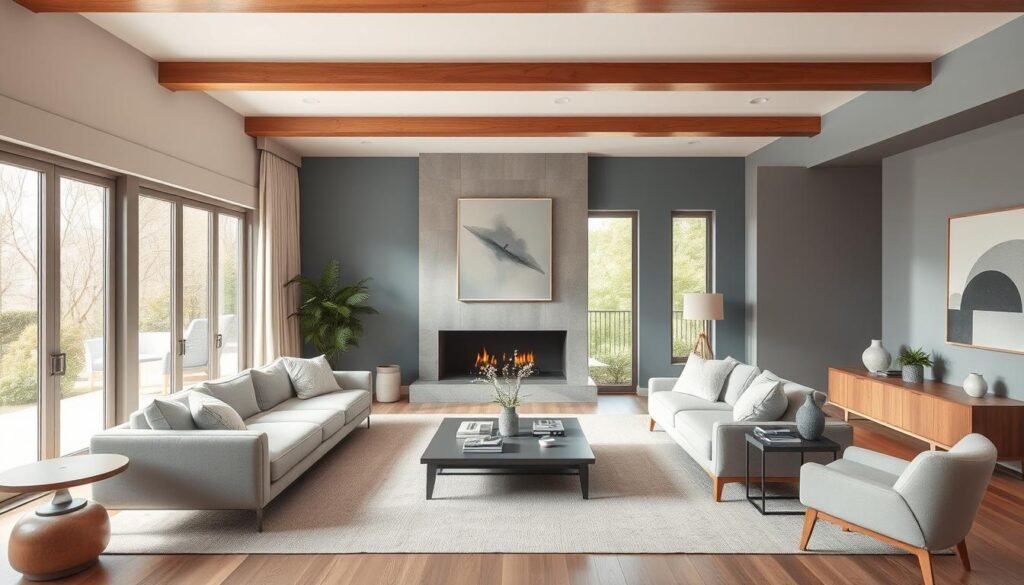
Contemporary design blends neutral colors with bold accents. Walls are painted in calm shades like white, gray, or beige. This lets colorful accessories shine.
Homeowners add vibrant colors like deep blues, rich reds, or earthy greens. These colors bring life and personality to the space.
Neutral Base Colors and Bold Accents
Contemporary interiors start with a neutral base. Black, white, and gray are the main colors. They offer a timeless look that fits with trends.
Then, bold colors like mustard yellow or deep indigo are added. These colors create a striking contrast and add depth.
Incorporating Natural and Industrial Materials
Contemporary design combines natural and industrial materials. Wood, stone, and jute add warmth and texture. Metal, concrete, and glass bring a modern touch.
This mix of materials creates a unique and engaging space. It’s a key feature of contemporary style.
Texture and Pattern Selection
Textures are important in contemporary design. They add depth and interest. Textured fabrics like wool or velvet in neutral colors make spaces cozy.
Patterns are simple and understated. Geometric motifs or subtle designs enhance the overall look. They match the color palette and materials.
| Material | Description |
|---|---|
| Wood | Natural wood, often in a light or weathered finish, is a popular choice for furniture and architectural elements in contemporary design. |
| Stone | Smooth, sleek stone materials, such as marble or quartz, are commonly used for countertops, fireplaces, and other focal points. |
| Metal | Metallic accents, including stainless steel, chrome, and brushed nickel, are used to add a touch of industrial flair to contemporary spaces. |
| Glass | Transparent glass elements, such as tabletops, shelves, and light fixtures, create a sense of openness and airiness in contemporary interiors. |
| Textiles | Soft, natural textiles like cotton, linen, and wool are used for upholstery, window treatments, and accessories to balance the hard surfaces. |
Furniture Selection and Placement for Contemporary Spaces
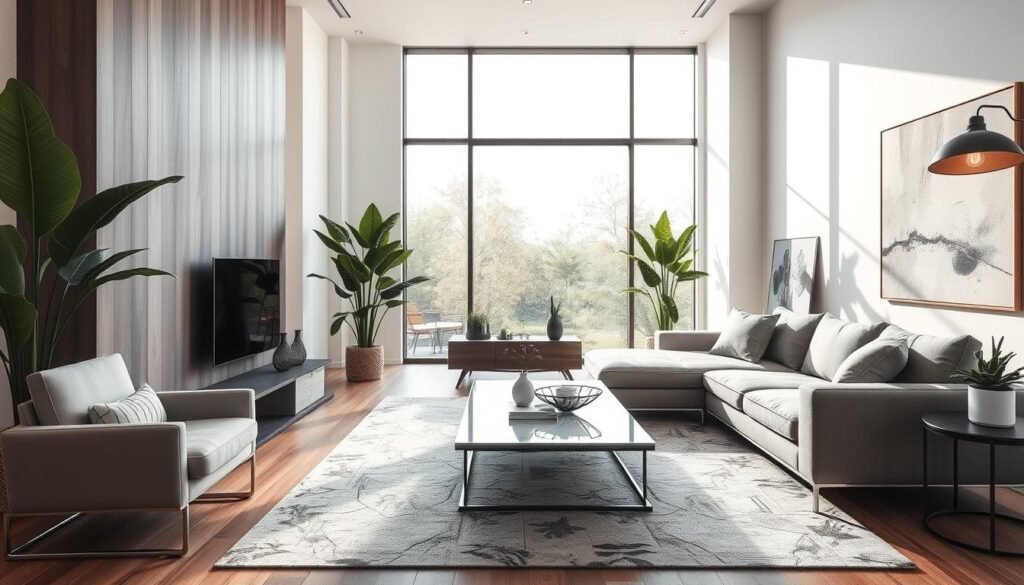
In contemporary interior design, choosing and placing furniture is key. Furniture should be simple and make a bold statement. It often has smooth shapes and exposed legs, showing off the materials.
Upholstered furniture in modern spaces usually has neutral colors and natural fibers like linen or cotton. Steer clear of too many decorations like ruffles or floral prints. Instead, go for furniture with clean lines and focus on function.
When placing furniture, aim for open spaces and let each piece shine. Use furniture to create zones for different activities in open-concept areas. Choose low-profile pieces to keep the room flowing well.
- Incorporate contemporary furniture with sleek lines and exposed legs to enhance the modern aesthetic.
- Select neutral-toned upholstered pieces made from natural fibers like linen or cotton.
- Avoid excessive ornamentation and focus on clean, geometric shapes that make a bold statement.
- Use furniture placement to define distinct zones within an open-concept layout.
- Choose low-profile pieces that maintain sightlines and promote a sense of openness in the space.
“The ultimate goal of contemporary furniture design is to create pieces that are both aesthetically pleasing and highly functional.”
By carefully picking and arranging modern furniture, you can make a space that’s both modern and welcoming. It will show off your style and the clean look of contemporary design.
Lighting and Architectural Elements in Contemporary Design
Lighting is key in modern design, adding both function and beauty. Track, recessed, and cove lighting create a warm glow. Spotlights or can lights highlight art or architectural details, focusing attention.
Strategic Lighting Choices
Modern lights often have simple, bold shapes. You’ll see cubes, spheres, squares, and cylinders. Linear pendants and cluster lights are favorites, showing off simplicity and usefulness. Materials like stone, glass, and eco-friendly options add to the modern look.
Architectural Details and Structural Features
In modern design, building elements are celebrated. Exposed beams, ductwork, or pipes are painted in bold colors or match the walls. This highlights the building’s structure, adding interest and authenticity.
Window Treatments and Natural Light
Modern design keeps window treatments simple, often with no treatments at all. This lets in lots of natural light, enhancing the space’s clean look. Big windows or glass walls are common, making natural light a key part of the atmosphere.
Also Read : How To Build A Successful Career As A Product Designer
FAQs
Q: What is contemporary design style in interior design?
A: Contemporary design style refers to a fluid and ever-evolving aesthetic that reflects current trends and ideas in the design world. It often emphasizes simplicity, clean lines, and an uncluttered feel, making it a popular choice for modern homes.
Q: How can I incorporate contemporary design style into my living room?
A: To create a contemporary living room, focus on a neutral color palette complemented by bold accents. Use contemporary furniture like a sleek sofa and oversized pillows, and incorporate design elements such as straight lines and geometric shapes. A statement piece of art or a contemporary chandelier can also enhance the space.
Q: What are some key design tips for achieving a contemporary kitchen?
A: For a contemporary kitchen, prioritize open floor plans and functional layouts. Opt for contemporary-style home decor with clean cabinetry, modern appliances, and a mix of materials. Incorporate contemporary colors, such as whites and grays, alongside splashes of vibrant hues for an inviting atmosphere.
Q: How do I choose the right contemporary furniture for my home?
A: When selecting contemporary furniture, look for pieces that feature minimalist silhouettes and functional designs. Choose items that work well together in terms of color schemes and materials. Consider elements like a contemporary coffee table or a stylish rug to tie the room together.
Q: Can you define contemporary style in terms of interior design?
A: Contemporary style in interior design is characterized by its focus on the present, rather than historical references. It blends modern design elements with a sense of comfort and livability, allowing for a harmonious balance between aesthetics and functionality.
Q: What are popular color schemes for contemporary bedrooms?
A: Popular color schemes for contemporary bedrooms often include neutral tones combined with accent colors. Soft grays, whites, and beiges create a calming environment, while a pop of color can be introduced through contemporary accent pieces like pillows or wall art.
Q: How do I maintain an uncluttered feel in my contemporary home?
A: To maintain an uncluttered feel in your contemporary home, prioritize storage solutions that hide clutter and keep surfaces clear. Choose multifunctional furniture that provides storage and select decor items that are meaningful, ensuring that each piece contributes to the overall design without overwhelming the space.
Q: What is the significance of lighting design in contemporary interior design?
A: Lighting design is crucial in contemporary interior design as it enhances the overall ambiance and highlights key design elements. Consider using a mix of natural light and modern fixtures, such as track lighting or sleek pendant lights, to create a warm and inviting atmosphere.
Q: How can I achieve a cohesive style throughout my home?
A: To achieve a cohesive style throughout your contemporary home, maintain a consistent color palette and design elements in each room. Choose contemporary furniture and decor that reflect a unified aesthetic, ensuring that every room feels connected while still allowing for individual character.

